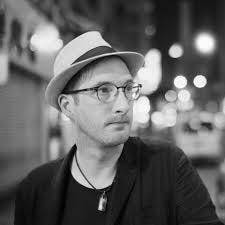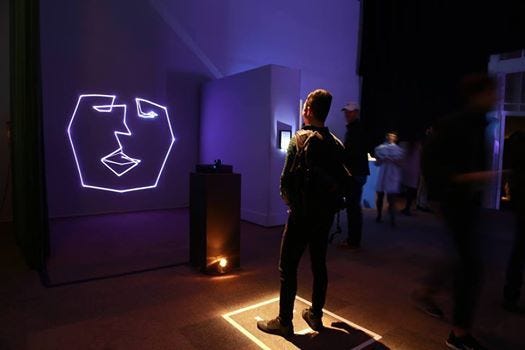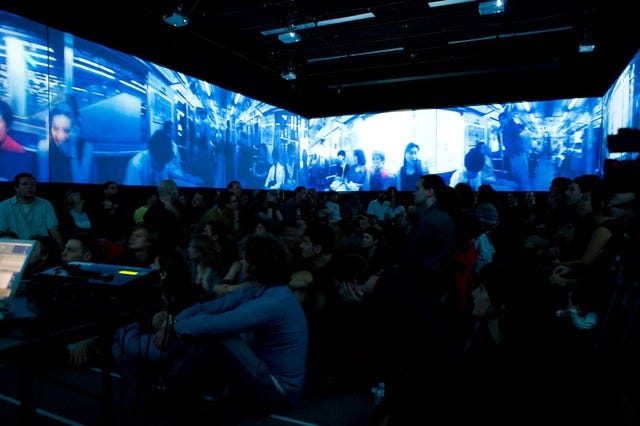An Interview with Barry Threw of Gray Area
This weekend, the Gray Area Festival is plotting “the future of world building through AR, VR, XR, installation, and immersion with four days of art, technology, music, and culture.” Barry Threw is Interim Executive Director at Gray Area in San Francisco, an organization that has been combining art and technology for culture for over ten years.
 Barry
Threw
Barry
ThrewTell us a bit about Gray Area
Gray Area is nearly eleven years old. I have been on the board and involved over the past decade. Its mission is art and technology applied for social and civic impact. It was started by Josette Melchor and Peter Hirshberg, originally as a gallery, akin to bitforms in NYC.
There was all this work emerging with artists using digital tools. The reason the technology sector blossomed is because of the cultural milieu of San Francisco. San Francisco has had a lagging art scene, but why wasn’t there something like bitforms for the community of coders?
Things started picking up steam after the dotcom crash. Gray Area was a warehouse space and then it moved to the Tenderloin, a historically disenfranchised area. Very quickly everyone decided they didn’t want to be a traditional art gallery. The process of making that work was just not fun for anybody. We went through several more spaces and, finally, a little over five years ago, ended up renovating the Grand Theater on Mission Street. It was a dollar store before we got it. A big part of the mission of Gray Area is to support community in a whole number of forms. We do work with local cultural organizations, the queer community, and historically marginalized communities in San Francisco.
How did getting the space work financially?
We have built the program up over ten years. About 80% of our revenue is earned income. This is supplemented by grants occasionally, but we really have built up a solid revenue model.
We have a couple of different programs. We do events, performances, and exhibitions that can be ticketed and bring in revenue, some of which we self-produce. We also do rentals of the space. We have an educational program, with short-term workshops as well as 10-week immersive creative coding and art-making programs. They culminate in a couple of showcases each year. Then we have an incubator program that is the next level for people who have projects and want to make them commercially viable. People will become members of that program, which is a cross between an incubator and a co-working space. That feeds back into our exhibition and performance programming.
So, we’ve done pretty well at creating a positive feedback loop in the programming, from education to the incubator to artists teaching or showing their work, and it’s kept people involved through the whole process.
 Interactive
face tracking workshop at Gray Area
Interactive
face tracking workshop at Gray AreaWe’ve joined forces with ZERO1 more recently. They used to run a biennial in San Jose for many years. That stopped happening, then they had a space called the ZERO1 Garage and now they run the American Arts Incubator. They’ve moved in with us and we operate the American Arts Incubator together. They do six to eight countries every cycle to arts spaces and institutions in those countries and then identify international artists to bring back to San Francisco. The mission aligns nicely.
What are the biggest challenges running Gray Area?
This gets back into why the space is uniquely important. We are a globally unique organization, like a combination between Eyebeam and NEW INC and Issue Project Room. We’re trying to integrate all that stuff into one ecosystem of arts and culture programming. That coupled with the social/civic impact mission. There’s an idea that artists should just sleep in their cloud and produce! We try to connect everything to the community we work in.
San Francisco is historically built out of creativity—for example the culture of the ’60s and the birth of the technology sector. However, the way that it has developed has been largely extractive locally at this point. You don’t find the technology sector feeding back into independent and local arts and culture in the way it used to.
Fifteen years ago people came for a different reason, largely for cultural reasons. Now it’s a gold rush mentality, people are flooding here to make money. A lot of artists have to leave. The economics of the area in general are a big challenge. Even people who are doing well are struggling. It’s not sustainable even for a couple working in tech. You can’t buy a house. There are people that are hanging on, but a lot of artists have left.
Some artists have technology jobs that have nothing to do with the creative sector per se. Some people have adjacent jobs in the tech sector, like content producers and immersive technology. The people who are primarily artists are generally struggling unless you’ve been grandfathered in. Even if someone becomes more famous, it’s much easier to go to LA, NYC or Berlin because the art gallery scene here is only just getting going. The art scene smelled enough blood that it is trying to get in on the SF wealth creation.
In so far as the economic worldview that San Francisco is exporting elsewhere, this is a hegemonic economy. If there is not a strong cultural and artistic component, then it is a failure. We try to espouse the idea that arts and culture has a direct place within the technology innovation process.
I’m stuck on the language around this, I’ve already set up a dichotomy between the two without meaning to. But we see this has a holistic practice that includes a lot of interdisciplinary practices that combine creativity with the technological process. When you say “arts and technology” you end up polarizing both communities. You put arts in the title and the technology community don’t feel included and vice versa. I don’t have a good solution to that but we are attempting to figure out how to build a good society that embracing both.
The Silicon Valley culture built up a certain amount of fuel that they are just burning at this point. There’s no sustainability. So we need to get this place to understand that cultural work is not a sideline nicety. You want workers who stay here and have things to do. You want a nice place to live and that includes culture for people. And perhaps more importantly, cultural work has a functional place within the actual technology and innovation process, or at least it certainly should have.
How does Gray Area think about immersive work?
It’s part of the full spectrum of what we do at Gray Area, but we contextualize it within the process of worldbuilding. You see this generalized trend in audiences being more interested in environments, a turn from objects to environments. People are sick of a bunch of white walls and objects, of homogenous gallery spaces. They want more site-specific environments that feel grounded, like they have a home.
It’s sort of a return, because if you think about how art was originally created throughout the millennia, cave painting was created within a certain environment, a very particular context, with fires creating sound and light. There was a site-specificity to it that is being replicated now that we can manifest worlds and environments. The 1980s-style commodified and decontexutualized white room for art objects is being reacted against.
San Francisco has history around immersive spaces that has created the conditions for this to be one of the centers of this kind of work. For example the Audium and Recombinant Media Labs. In 2006–2008 at Recombinant Media Labs, which I am also involved with, we created a surround video environment that ended up going to festivals and touring. We occasionally show that at Gray Area. The original goal was to make a replicable surround cinema format. There’s also a lot of history history here around immersive media such as virtual reality—Jaron Lanier’s work at VPL for example.
 Recombinant
Media Labs Surround Cinema
Recombinant
Media Labs Surround CinemaThere are more and more people using art and technology to create immersive experiences. You see things like Museum of Ice Cream and Meow Wolf. You also can’t get Burning Man out of the conversation in San Francisco, whether you want to or not. It’s an entry point for a lot of people into larger-scale site-specific or environmental work. It’s extremely interesting that we take a lot of our cultural energy and resources and drive it out to the dessert and burn it each year rather than building it into the infrastructure that stays here—but it’s still a semi-permeable membrane. A petri dish for stuff that grows legs and comes back.
People are going to these experiences, some of these spaces are making a ton of money. People want to go for their Instagram shots, they want to be in these environments. But the content is pretty vacuous in many of these environments. There’s more meat to the Meow Wolf experience, but you don’t leave with any core values or real-world engagement or impact. There’s so much in there that you get disoriented and your mind is fragmented by the multiverse they create.
One of the big ideas we are trying to explore is how to engage all of the senses into a worldbuilding exercise. This is clearly a powerful medium. How can we move beyond a superficial experience which is technologically sublime?
Right now the trend is to have a lot of something small, paint it all blue, put it on all the walls. But there is something real about this idea of worldbuilding and simulation as a cognitive tool. There’s something about the idea that we are in a world that is dying and I don’t think it is a coincidence that these worldbuilding practices have sprung back up when the literal world is dying. There’s a traumatic reaction to people’s conception about what the world is that feeds back into the notion of creating alternate realities and environments.
What other projects are you working on at Gray Area at the moment?
In the fall, supported by the Knight Foundation, we did an open call (Experiential Space Research Lab) for artists to prototype a couple of spaces that will open in December in Gray Area. The framing was around understanding the earth as a living system. How do we use immersive and sensorial environments to not just be disorienting, but connect it back to how we understand and orient ourselves to this planetary crisis? How can we use immersive practice as knowledge-building instead of just distraction or entertainment?
There was a distancing effect from seeing the earth from space. This sort of work in terms of simulation and immersive environments is perhaps not only useful but a necessary step in helping to work through people and society’s relationship with the environment and planet they are on—one towards engagement and not escape.
There are a lot of escape paths: Let’s go to Mars! We’re really interested in using this practice to engage and try to make some headway on the environments we’re in. In a place like San Francisco where there are problems with extractive culture and technology not engaging with the issues we are facing, how can art and technology do this?
We’re not just thinking about headsets. We’re mostly looking at built environments that you walk into—but I don’t think that virtual and augmented are separate from this. They are manifestations of the worldbuilding practice as a medium to work through what you are trying to communicate. They are all part of a big continuum. Sound is part of that too, to create a sensorially immersive experience.
There’s a real economic case for this work in San Francisco, which is important because this is how you need to speak to the technology and business community. This practice will end up becoming a viable economic space that can support culture in the ecosystem. And San Francisco should be the place where this kind of work can be nurtured. The biggest cost here right now is the cost of space, which is why it will veer toward VR and AR because you don’t need as much space. It’s also why Gray Area is important, we have space and can make it accessible.
This piece is part of an issue of Immerse sponsored by the Knight Foundation in conjunction with Knight’s call for ideas to advance immersive arts experiences. Open for applications through August 12, the call offers recipients a share of $750,000 in funding, as well as optional technical support from Microsoft. Learn more.
Immerse is an initiative of the MIT Open DocLab and The Fledgling Fund, and it receives funding from Just Films | Ford Foundation and the MacArthur Foundation. IFP is our fiscal sponsor. Learn more here. We are committed to exploring and showcasing media projects that push the boundaries of media and tackle issues of social justice — and rely on friends like you to sustain ourselves and grow. Join us by making a gift today.